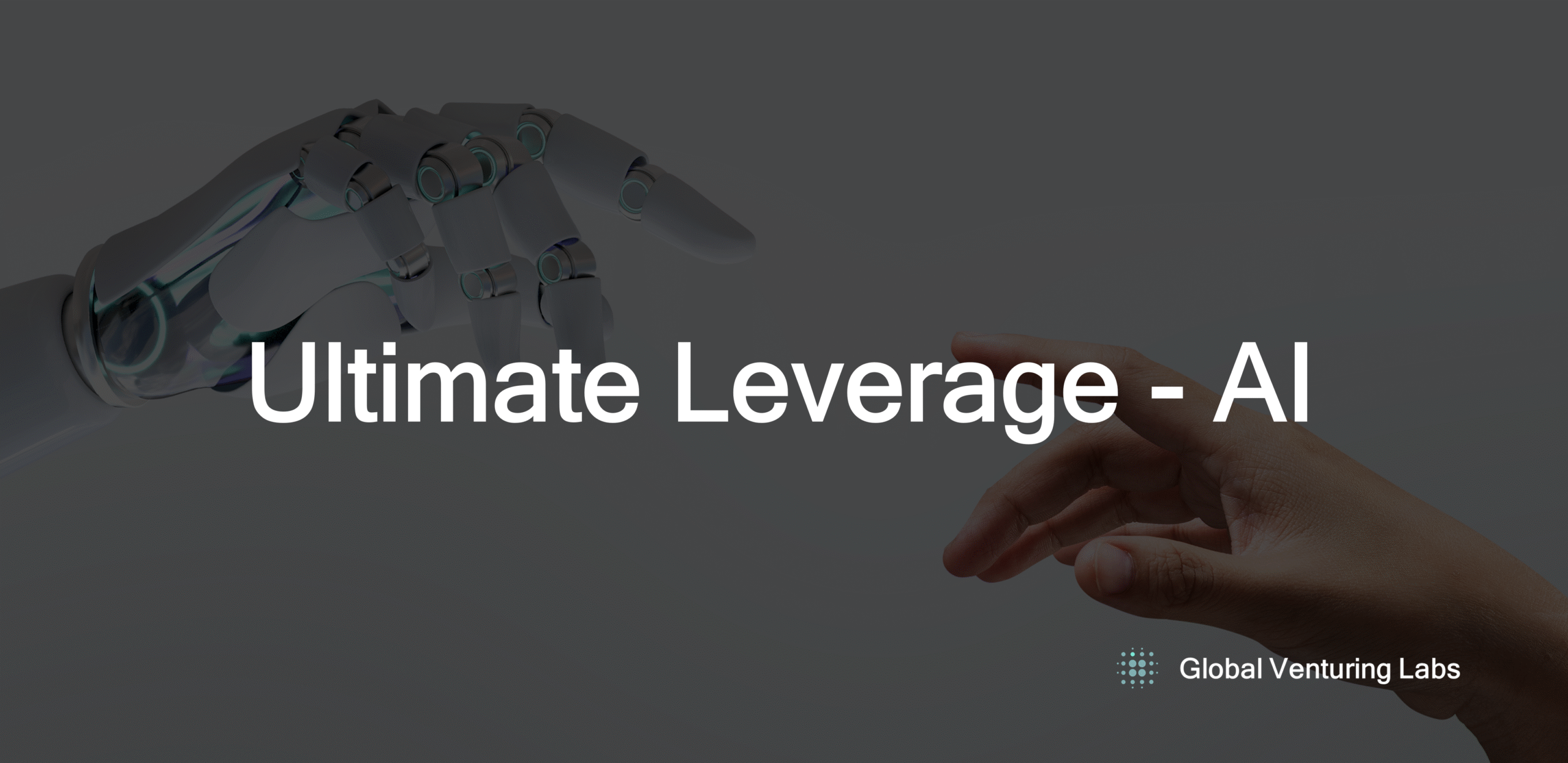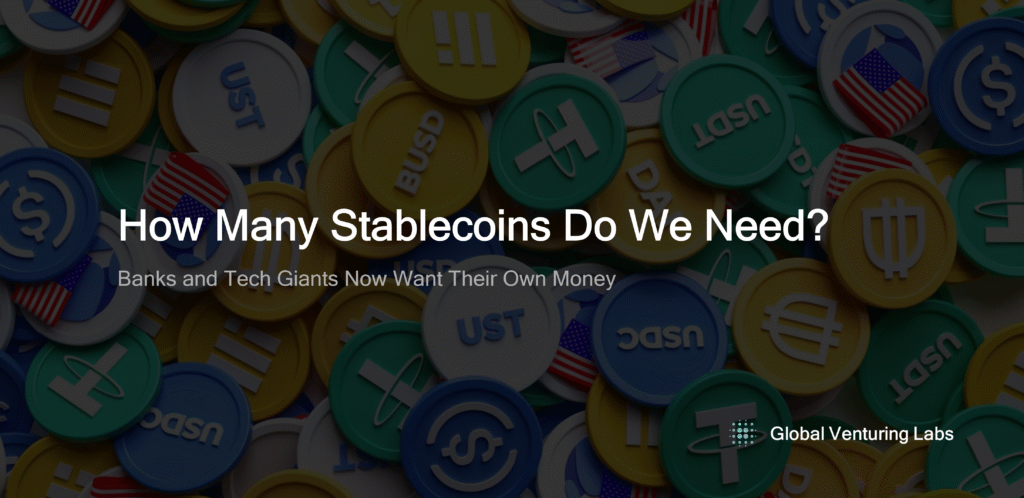AI as An Ultimate Form of Leverage – Dr. Hyung Won Chung
At GVL, our goal is to distill actionable insight from global thought leaders to help founders and investors navigate the future. A prime example is the recent framework presented by Dr. Hyung Won Chung, a leading AI researcher formerly at OpenAI, specialized in reasoning, agents, and models like o1-preview, o1, and Deep Research.
Holding a PhD from MIT and with prior roles at Google Brain, he has pioneered advancements in large language models. Recently, rumors surfaced of a $300 million, four-year offer from Meta to recruit him and colleague Jason Wei for its superintelligence lab, highlighting intense AI talent competition. In his May 2, 2025, Cornell lecture “AI as an Ultimate Form of Leverage,” Chung leveraged his OpenAI insights to discuss AI’s amplification of human capabilities, using analogies like budding flowers to highlight underestimated tech changes.
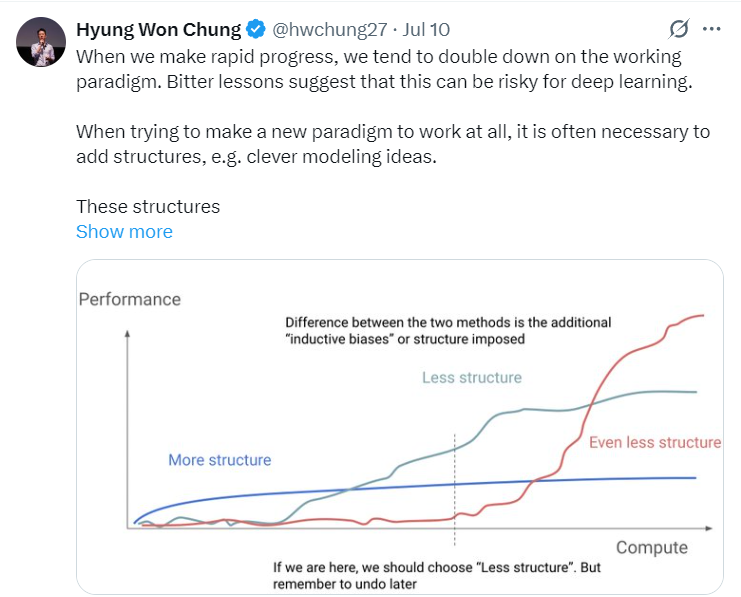
From Chung’s Cornell lecture, the key foundational ideas on AI’s role include:
- Perceptual Deficiency in Change: Evolutionary biases make us miss slow, long-term shifts, causing underestimation of AI’s rapid, profound evolution as history’s fastest tech.
- Leverage Mechanism: It decouples effort (input) from value (output) for amplified results; better than just working harder, it’s about small changes yielding big gains.
- Historical Leverages: Per Naval Ravikant: human labor (permission-based, e.g., team hiring), capital (return amplification, e.g., loans), and code/media (scalable replication, e.g., apps/videos)—wealth creators whose edges fade with competition.
- AI as New Leverage: A hybrid of labor (task automation via agents) and code (replicable scaling), nascent and high-potential for individual boosts to global advancements before saturation.
- Individual Impacts: Reduces learning barriers (e.g., ChatGPT tailoring), but elevates scarcity of curiosity; agents empower small teams, minimizing large-group overhead.
- Humanity-Scale Role: Accelerates science by bridging expertise gaps, synthesizing knowledge “overhangs,” and enabling superhuman reasoning for endless research engines.
- Reassess Scale: Reflect on underestimating AI’s magnitude as a thriving leverage, correcting biases to grasp its value redefinition across levels.
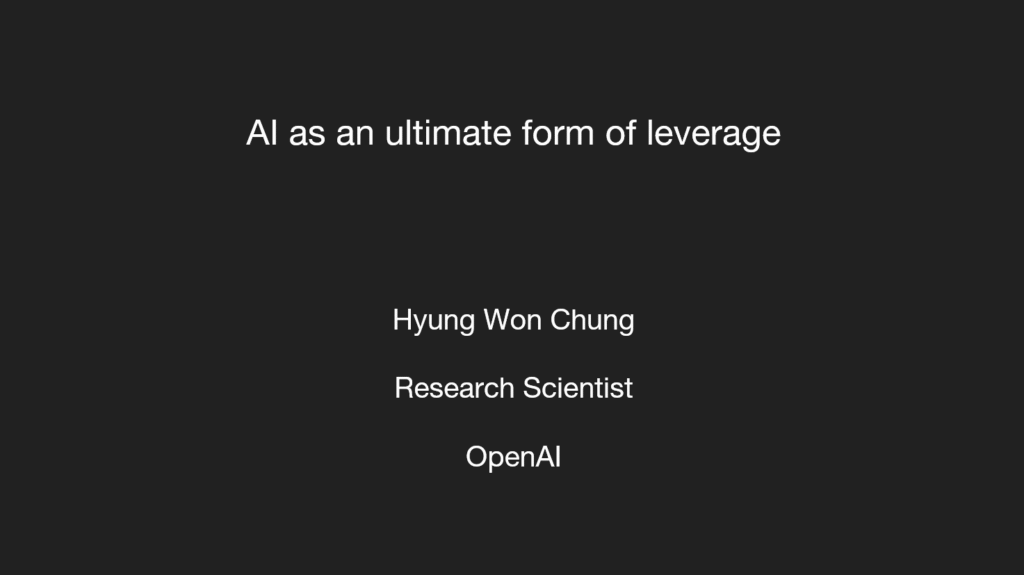
Perceiving Change in a Fast-Moving Field
To illustrate a key point, consider a ChatGPT-generated image of a budding flower. If you stare at it for a minute or even ten minutes, you won’t notice any change. Does that mean nothing is happening? Of course not—underlying processes are at work. Wait long enough, and you’ll see it bloom into a full rose.
This toy example highlights a human limitation: we’re not great at perceiving changes that unfold over minutes, days, or years. We’re better at noticing shifts on the scale of minutes to hours, likely due to evolutionary pressures—spotting immediate environmental changes aids survival, while long-term shifts matter less for day-to-day living. This built-in deficiency is something we need to correct.
Why bring this up? AI is probably the fastest-moving technology in history, yet it doesn’t advance in minutes or hours—it evolves over years or decades. Given our perceptual blind spots, we might be underestimating the magnitude of change AI is bringing. At this point, I don’t need to convince anyone that AI is important; that’s a given. But the scale of its impact varies widely in people’s minds, and if anything, we’re underestimating it—especially AI’s role as a leverage mechanism for individuals and humanity. I’ll dive into what I mean by that, building intuition step by step around the keyword: leverage.

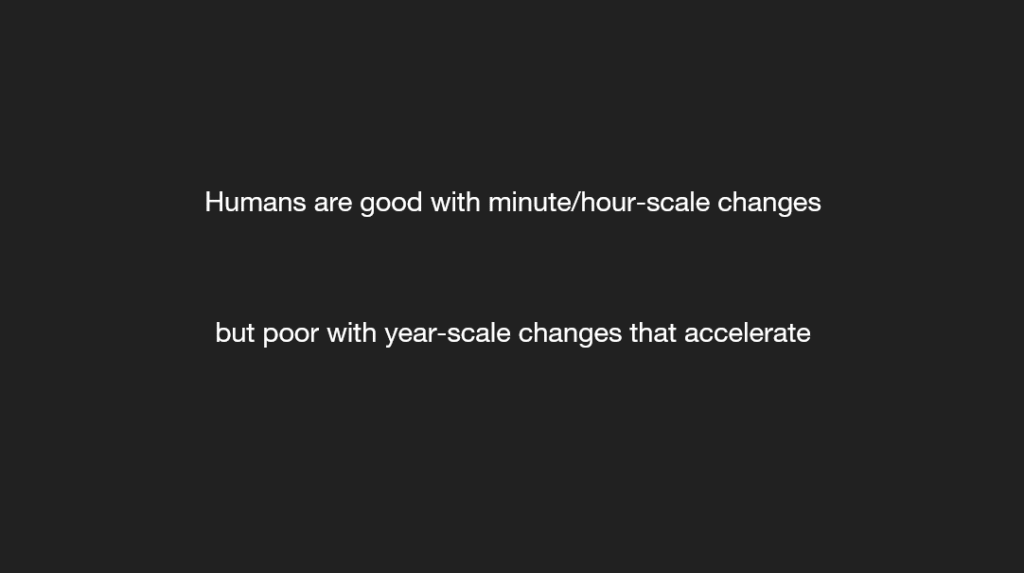
Understanding Leverage: A Core Concept
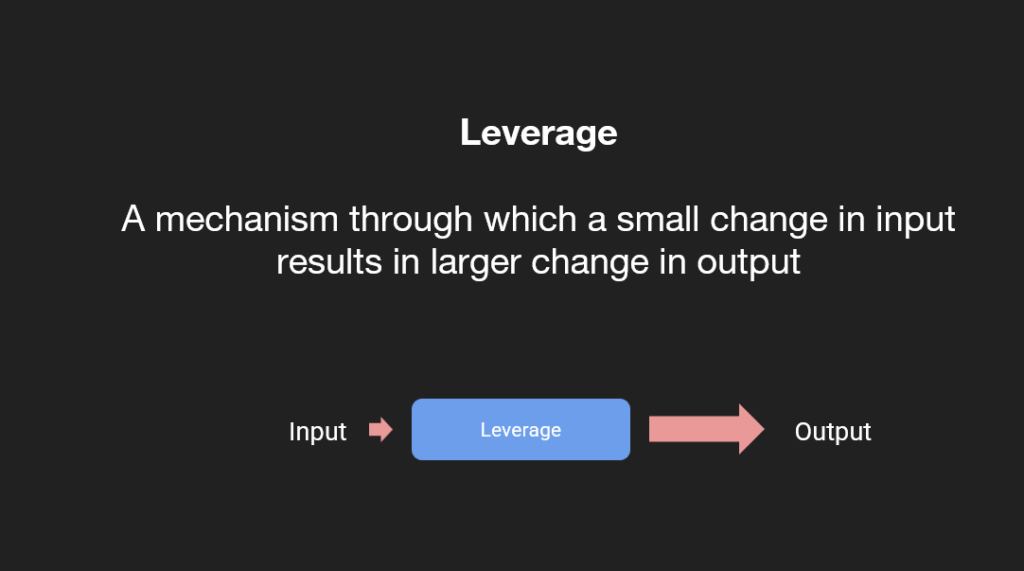
Leverage is a crucial, often casually used term, especially in Silicon Valley. It’s worth building intuition around it. My first encounter was in classical mechanics with a simple lever. Imagine applying downward force on one end to lift a 1-kilogram mass on the other. Extend the lever, and you can lift heavier objects. The input force stays the same, but the output multiplies—say, by 3x.
This is a general concept: leverage is a mechanism where a small or no change in input leads to a large change in output. It’s not limited to physics; it applies broadly. Many people want to increase output—to contribute more or generate more value. The instinctive response is to work harder: increase input by sleeping less or pushing harder. But there’s a limit to that. The smarter question is: How can I boost output without increasing input, or decouple the linear relationship between them?
That’s the essence of leverage. If you want more output, identify and apply leverage mechanisms. One of my favorite frameworks comes from Naval Ravikant, whose thoughts are collected in a book I highly recommend (a compilation of his tweets and ideas). According to Naval, there are three main types of leverage: human labor, capital, and code/media.
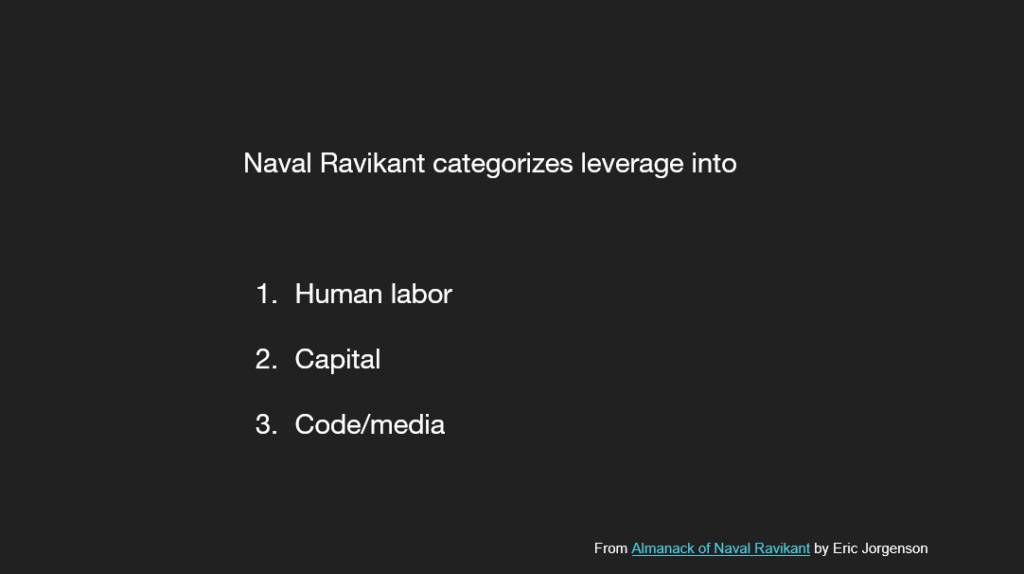
- Human Labor: The Oldest Form
This is the most familiar and ancient leverage. Without it, building a pyramid alone would be nearly impossible. With leverage, I can hire thousands of workers. My input decreases—I might not even work much—but the output soars because others are contributing. This requires permission, as I need people to agree to work. It’s still a dominant mechanism in society.
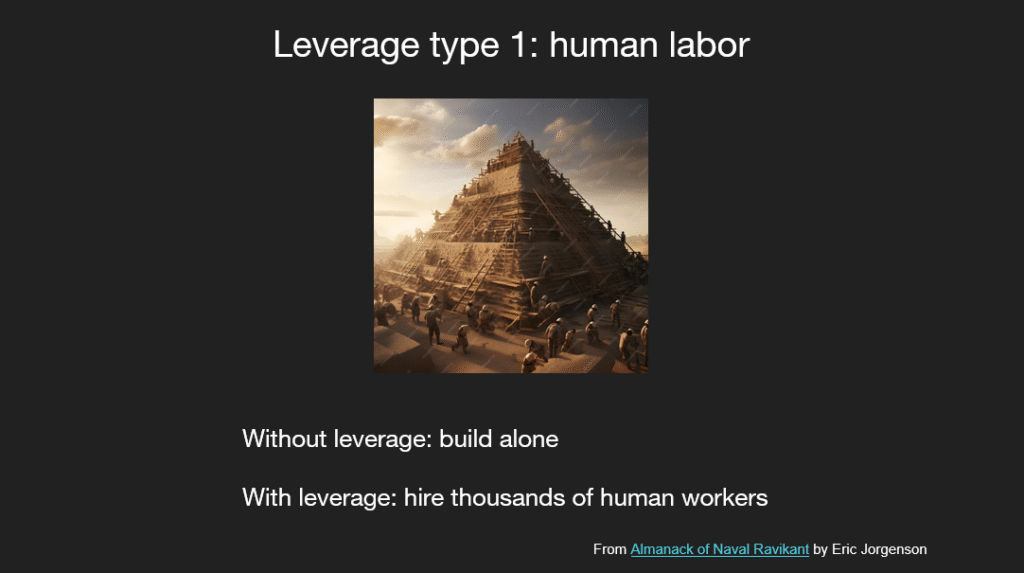
- Capital: Amplifying Returns
Common in the 20th century, consider investing in $1 million real estate with only $200,000 of my own money, borrowing $800,000 from a bank. If the value doubles to $2 million, my return isn’t just 100%—it’s 400-500% due to the borrowed capital. This multiplies outcomes disproportionately.
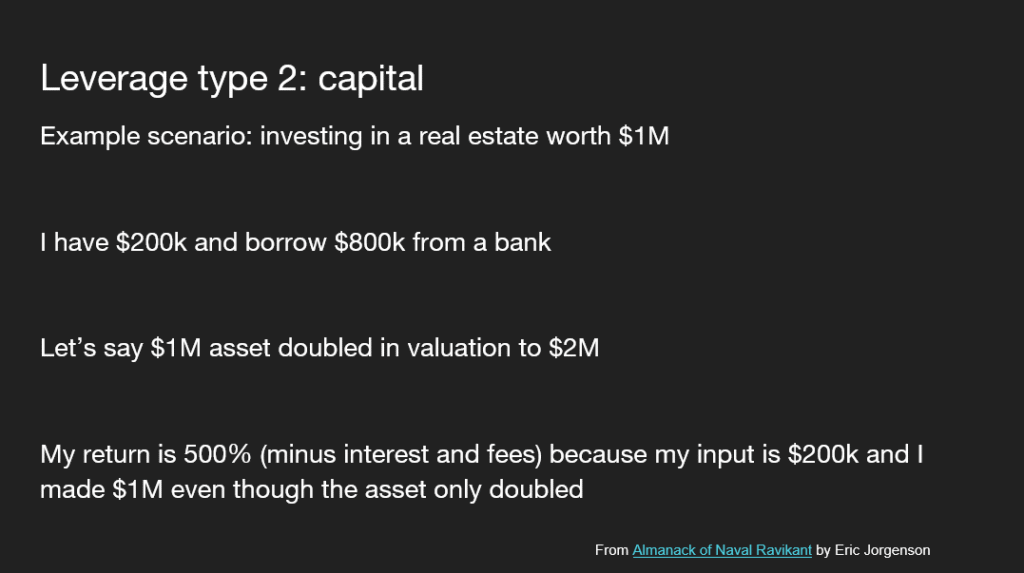
- Code and Media: Permissionless Scaling
More recent, especially in tech, code allows infinite replication. If I build an app that delivers value n to one user, while I sleep, another user downloads it, adding another n—doubling value without extra work. Software’s copy-paste nature enables this. Media works similarly: If I lecture to 200 people, delivering positive value, posting it on YouTube means every additional view adds value without effort from me. The potential is endless.
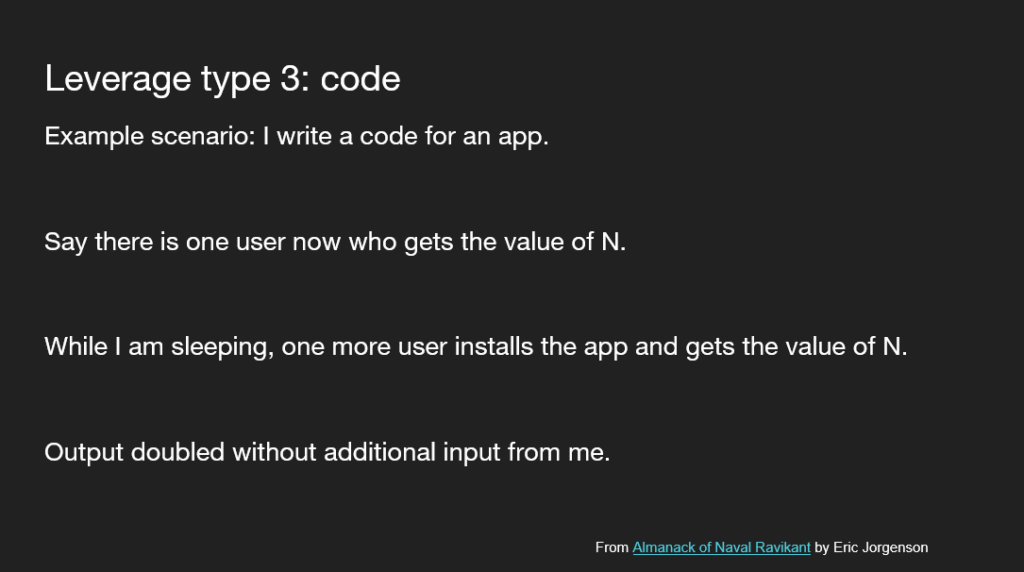
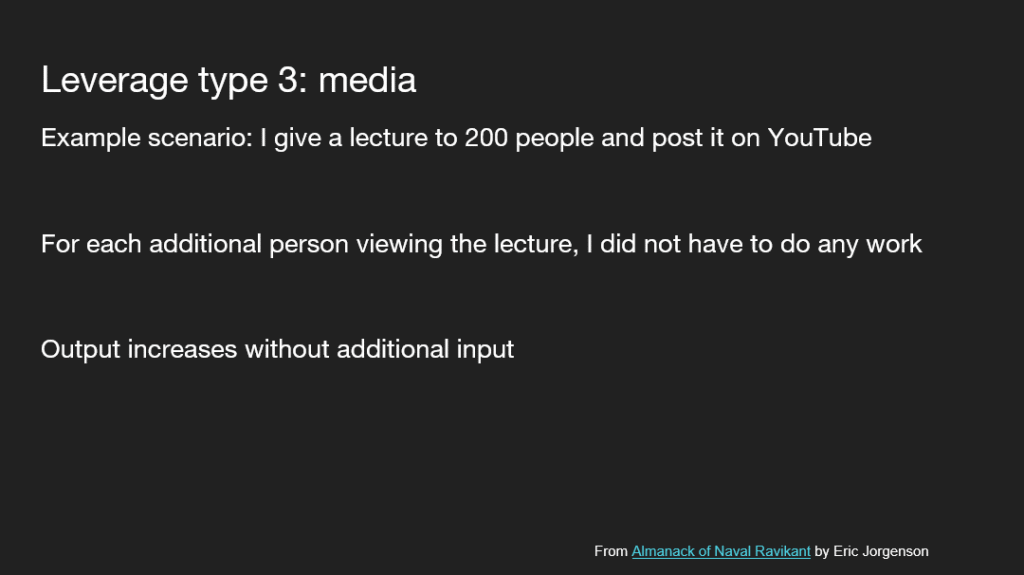
Historically, massive wealth creation has relied on these leverages. 20th-century finance used capital; recent tech giants exploited code’s scalability. But upsides get competed away—software startups face tougher competition today than 20 years ago, and becoming a YouTuber is harder now than a decade ago. When a new leverage emerges from technology, it enables huge value; over time, competition erodes it. So, it’s vital to spot emerging leverages. I argue AI is a relatively new one, expanding from individuals to groups and humanity at large.
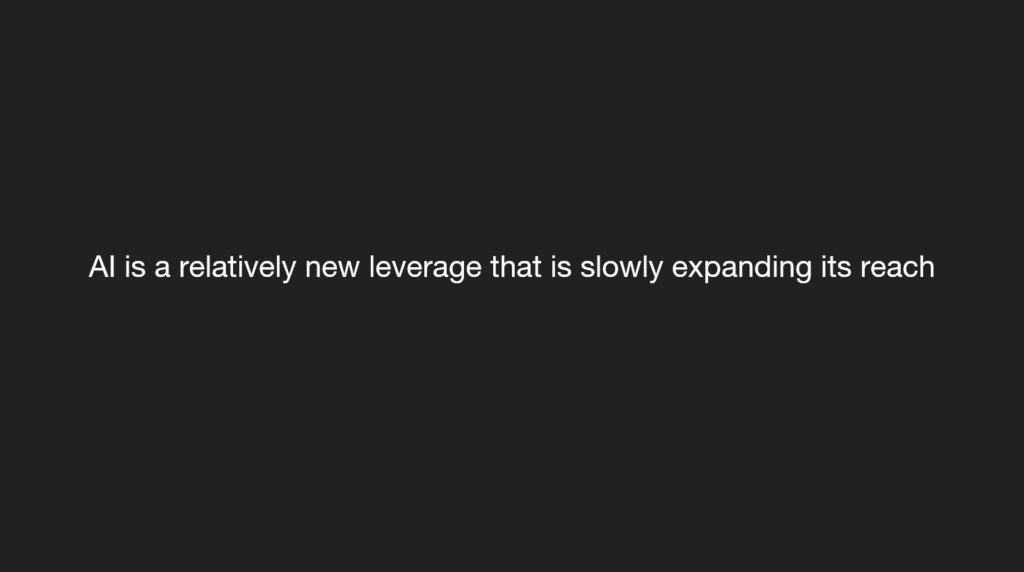
AI as Leverage at the Individual Level
Starting small, I personally use AI (like ChatGPT) most for education. I spend weekends learning new concepts, often for hours. In leverage terms, input is my time and effort; output is conceptual understanding in my brain.
AI amplifies this: To learn about distributed systems pre-generative AI, I’d Google, hit a non-beginner-friendly Wikipedia page, feel discouraged, then hunt for courses or textbooks—building context just for one idea, which is time-consuming. Now, AI contextualizes what I know, generating tailored materials at the right difficulty. Barriers to learning new areas are collapsing.
This is great, but we need a comprehensive view. When learning is easier for everyone, the opportunity cost of not learning rises. If others use AI to upskill while you don’t, you fall behind—not from laziness, but relative stagnation.
Valuable skills are determined by supply and demand, not objective worth. Human vision is objectively advanced (computer vision studies highlight its feats, like recognizing friends in tough settings), but it’s abundant, so it doesn’t confer advantage. Scarcity is key for value. Evolution-equipped skills (everyone has them) aren’t scarce—look for what it didn’t provide.
As knowledge acquisition cheapens, curiosity and motivation to explore become scarcer and more vital. Learning still has costs; it’s cognitively challenging and uncomfortable. Curiosity drives overcoming that: “I know there’s pain, but I’m driven to know.” Alternatively, build reward cycles: short-term pain for long-term fulfillment.
Broader, technology shifts scarcity—being aware of this, even if not creating it, is crucial.
Another intuitive AI leverage: agents, a hot 2025 research area. Agents combine human labor (they work for you) and code (software-based, replicable without permission). Want 10 agents? Copy them; need 12? Add two more. This composite is profound.
It’s new; Deep Research is the best-functioning agent I’ve used, boosting my (and others’) output. Individuals are supercharged, enabling small teams (10-20 people) to generate hundreds of millions in revenue—unimaginable a decade ago, but happening now via AI leverage.
Previously, to scale output, you’d raise capital or hire (human labor), but large-scale collaboration has overhead: communication, conflicts. Adding one person to a 100-person team might not increase output by 1%—it could decrease. With supercharged individuals, smaller teams become more viable, potentially more common alongside big companies.
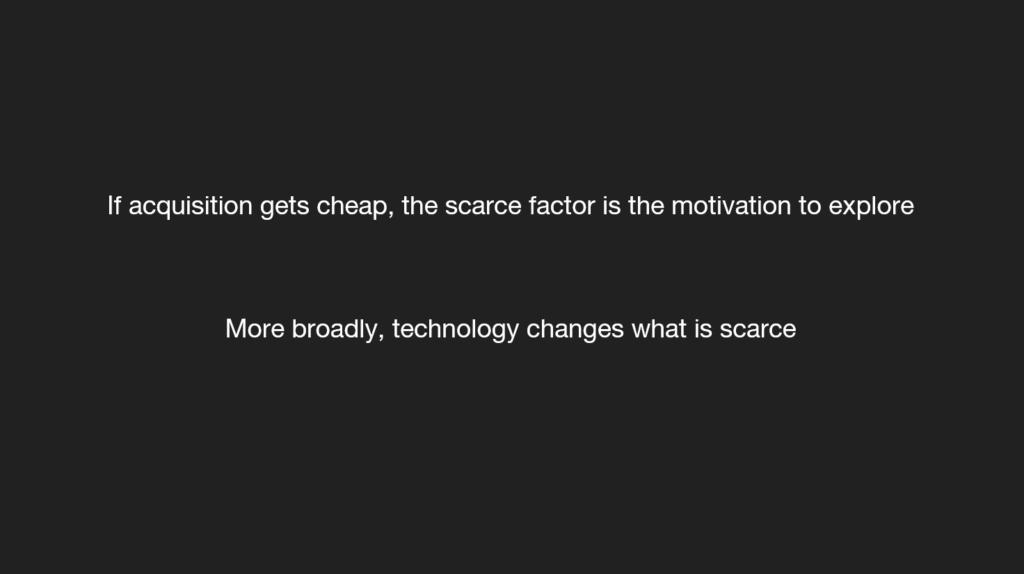
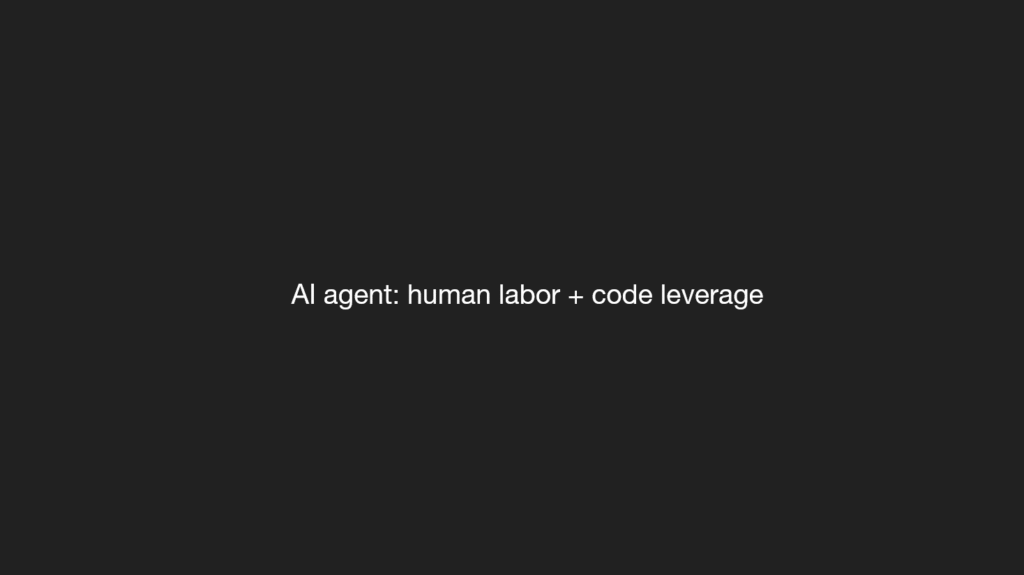
AI as Leverage at the Humanity Level
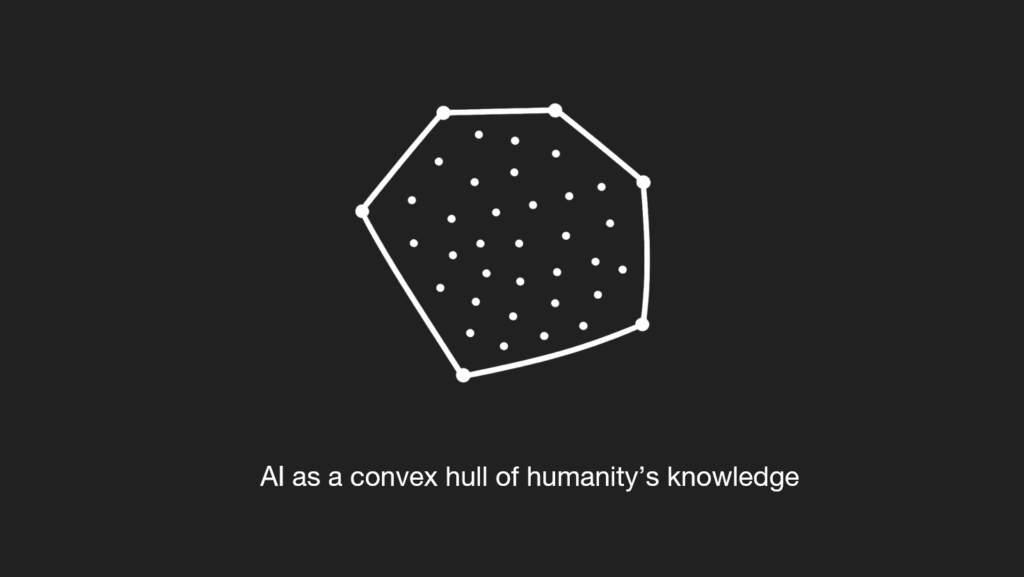
So far, individual and group implications. Like the flower analogy, this change is massive but slow, often underestimated. At humanity’s scale, our goal is thriving through value creation. The most sustainable engine? Scientific advances—turning non-resources into resources (e.g., oil from sticky liquid to energy via thermodynamics).
Since the 17th-century Scientific Revolution, wealth has hockey-sticked. Back then, low-hanging fruits abounded; early science was simpler (Newtonian vs. quantum mechanics). Today, advancing chips or tech exceeds single-human capability, requiring large collaborations, capital, and facing stagnant human intelligence against rising complexity. This bottlenecks progress.
We’ve always built tools to unblock bottlenecks; AI should be that tool—perhaps superhuman in research—to sustain advances. To me, this is AI’s paramount purpose: augmenting scientific progress.
In leverage terms, input is collective human effort; output is progress. AI helps two ways:
First, specialists are encouraged, but segregated by fields, locations, communities—hard to collaborate or even know options. Human knowledge is spiky, high-dimensional, with gaps. AI envelops this, connecting spikes—like a convex hull in optimization—making cooperation efficient, reducing overhead.
This suggests a huge overhang: synthesizing existing knowledge could yield massive value (new knowledge from old). Communication bottlenecks have left this uncharted; AI plucks these low-hanging fruits.
But we need more: advanced reasoning surpassing human scientists, generating ideas. Anecdotes exist (o3 as brainstorming partner), but expect more in future models. This creates non-stop research engines, collaborating across humans and agents—the ultimate leverage for scientific mission.
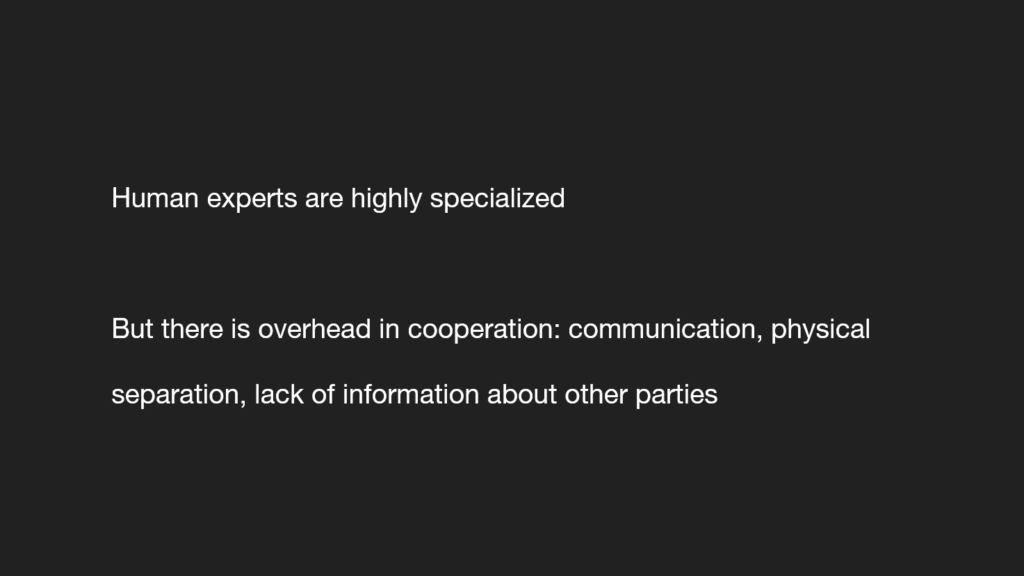
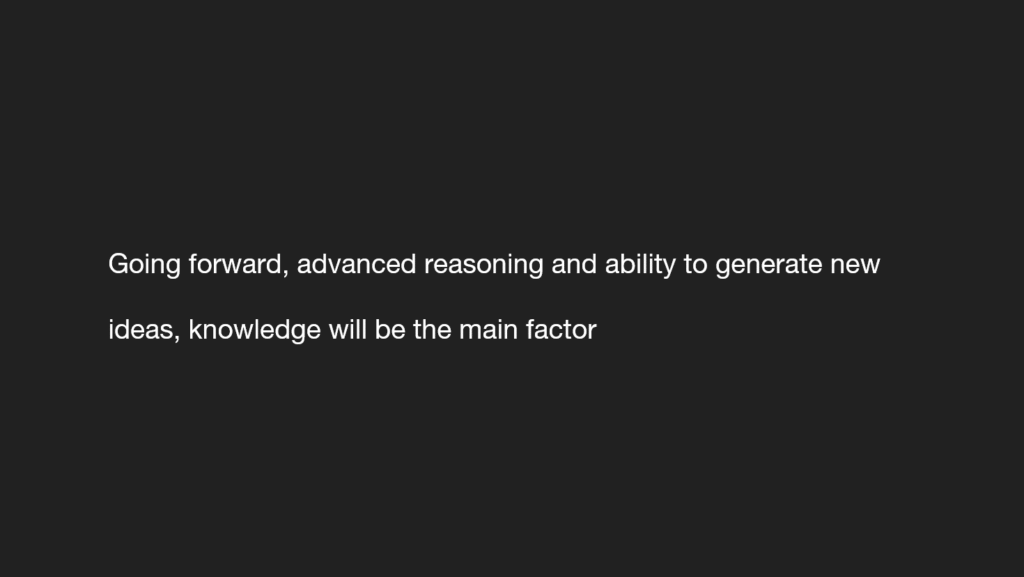
GVL Takeaways for Founders and Investors:
The key insight from Dr. Hyung Won Chung’s presentation is to view AI as a fundamental new form of leverage, not just another technology. This critical shift in perspective yields five actionable takeaways for founders and investors:
-
Embrace AI as a New Foundational Leverage. View AI not just as a tool, but as a new form of leverage combining the task execution of labor with the infinite, permissionless scalability of code. This allows small, “supercharged” teams to achieve unprecedented output and disconnect effort from results, fundamentally changing the economics of building a company.
-
Act with Urgency to Capture Early Returns. Every new form of leverage—from capital to software—offers a brief window of outsized returns before the opportunity is competed away. The current wave of AI presents such a window. Founders must ship quickly, and investors must identify teams that are integrating this leverage now, not later.
-
Architect for Permissionless, Exponential Scale. The unique power of AI agents lies in their software nature. Build business models and technical architectures that exploit the ability to replicate and deploy intelligent agents instantly and at near-zero marginal cost. This creates a non-linear relationship between your input and the value your company generates.
-
Invest in Curiosity, Not Just Knowledge. As AI makes information acquisition cheap, the new scarce—and valuable—resource becomes the human motivation to explore, ask novel questions, and synthesize disparate ideas. Investors should back founders who embody this deep curiosity, as it will be the primary engine of innovation in an AI-powered world.
-
Target Humanity-Scale Problems and “Knowledge Overhangs”. AI’s ultimate purpose may be to accelerate scientific progress by solving problems too complex for human intelligence alone. Seek opportunities where AI can synthesize vast amounts of existing but siloed knowledge (the “overhang”) to create breakthroughs. Underestimating this magnitude risks missing the most sustainable value-creation engine of the next generation.
The Original YouTube Video
About Global Venturing Labs (GVL)
We warmly welcome you to join our collaborative tech-driven venturing ecosystem.
GVL is a tech-driven venturing platform that empowers innovators by harnessing next-generation technologies, with a focus on AI and blockchain, to fund innovative ideas and drive wealth creation. GVL fosters an ecosystem where founders, investors, tech experts, and visionaries collaborate seamlessly, transforming concepts into reality in a new era of decentralized venture creation.
Mission and Pillars
- Co-Knowledge Base – Delivering actionable insights, tools, and real-world examples to guide innovators in building thriving ventures. We empower our partners to share their expertise, fostering collective growth and innovation.
- Co-Community Networks – Fostering a global network of visionaries-founders, tech experts, investors, and enthusiasts – to connect, collaborate, and drive innovation.
- Co-Venture Platform – A future decentralized, DAO-based platform empowering members to launch businesses and invest through community-driven funding. We aim to provide values beyond capital.
Join us for the next-gen collaborative venturing!

